If you want to keep your kitchen clean without spending a fortune, you'll be pleased to know that many effective cleaning solutions are already in your pantry. Ingredients like vinegar, baking soda, and lemon juice are not just good for cooking; they serve as excellent cleaning agents too.
For example, vinegar is great for cutting through grease and removing odors, while baking soda can tackle tough stains and act as a gentle scrubber. Lemon juice not only leaves a fresh scent but also has natural antibacterial properties that help disinfect surfaces.
Using these natural ingredients not only helps you save money but also contributes to a healthier home environment, free from harsh chemicals. If you're curious about how to use these items effectively, here are some practical tips:
- For Kitchen Surfaces: Mix equal parts vinegar and water in a spray bottle. Spray it on countertops, let it sit for a few minutes, and then wipe it down with a cloth for a sparkling finish.
- For Stubborn Stains: Create a paste with baking soda and water, apply it to the stained area, and let it sit for about 15 minutes before scrubbing it away.
- For Freshening Up the Fridge: Place an open box of baking soda in your fridge to neutralize odors. You can also wipe shelves with a mixture of lemon juice and water for a fresh scent.
By incorporating these simple yet effective methods into your cleaning routine, you can enjoy a cleaner kitchen while keeping your budget intact.
Let's explore these natural solutions further and see how they can transform your cleaning habits for the better!
Key Takeaways
Here are some budget-friendly natural cleaning tips for your kitchen that you can easily incorporate into your routine:
First up, a simple and effective cleaning spray can be made by mixing equal parts of vinegar and water. This combo works wonders for tackling stains and eliminating odors, making your kitchen feel fresh and clean without breaking the bank.
Next, consider using baking soda. It's like a little powerhouse in your cleaning arsenal! This versatile scrub can help you tackle tough messes on various surfaces. Plus, it's non-toxic and eco-friendly, so you can clean without worrying about harsh chemicals.
Lemon juice is another fantastic natural cleaner. It's great for sanitizing cutting boards, and it not only gets rid of bacteria but also neutralizes odors. The fresh scent of lemon can brighten up your kitchen environment, making it a more pleasant place to cook and gather.
For shining surfaces and keeping dust at bay, try a polishing solution made from olive oil. Just a small amount can go a long way in giving your kitchen a polished look while promoting a healthier indoor atmosphere.
Lastly, if you're looking for a DIY disinfectant, combine hydrogen peroxide and water. This mixture is safe for most kitchen surfaces and is effective against germs, giving you peace of mind as you prepare your meals.
By using these natural cleaning solutions, you'll not only save money but also create a healthier space for yourself and your family.
Vinegar for Stain Removal
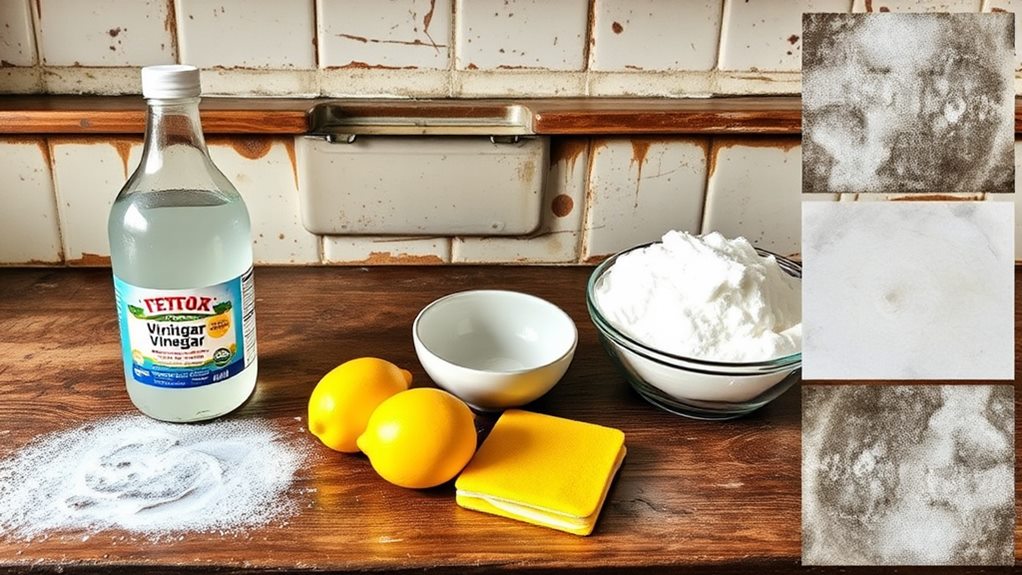
When it comes to removing stubborn stains in your kitchen, vinegar is an incredibly effective tool you should have on hand. It's not just for adding flavor to your salads; this simple ingredient offers a range of benefits that make it an ideal cleaning solution.
Whether you're facing greasy spots on your countertops or pesky water stains on your appliances, vinegar can help bring back the shine to your kitchen.
To use vinegar for cleaning, start by mixing equal parts vinegar and water in a spray bottle. This easy solution can handle many kinds of stains. Just spray it on the stained area, let it sit for a few minutes, and then wipe it off with a clean cloth.
If you're up against tough stains, consider using undiluted vinegar for a stronger punch. Its natural acidity works wonders in breaking down grime without the need for harsh chemicals, making it a safer choice for your home.
In addition to tackling stains, vinegar also helps deodorize your kitchen, leaving it smelling fresh. A neat trick is to place a bowl of vinegar in your fridge; it's great for absorbing any unpleasant odors lingering inside.
With these vinegar methods at your fingertips, you can keep your kitchen looking spotless without breaking the bank. Embrace the power of vinegar, and you'll enjoy a cleaner and healthier cooking environment!
Baking Soda as a Scrub
Baking soda is an incredible tool for keeping your kitchen clean. It's not just effective; it's affordable and versatile, making it a go-to for tackling tough messes.
When you have baked-on food or stubborn stains on your countertops, a simple paste of baking soda and water can work wonders. Just mix the two together, apply it to the affected area, and scrub gently with a sponge. You'll be amazed at how easily it lifts grime away.
Using baking soda regularly can change the way you approach cleaning. Instead of relying on expensive chemical cleaners, you can use this simple ingredient to keep your kitchen looking its best while also being environmentally friendly.
Plus, it's easy to find—most people already have it in their pantry! So, next time you're faced with a tough spot, remember that a little baking soda can go a long way in making your cleaning routine more effective and budget-friendly.
Multi-Purpose Cleaning Power
Baking soda is an incredibly useful tool for cleaning your kitchen. Not only is it affordable, but it also works effectively as a scrub for various surfaces like your sink, stovetop, and countertops. To use it, just mix baking soda with a bit of water until you have a paste. This simple mixture becomes a powerful scrub that's gentle enough for most surfaces.
If you want to boost its cleaning power, try combining baking soda with vinegar. When these two ingredients mix, they create a fizzing reaction that helps lift dirt and grease, making your cleaning routine even more efficient. This combination is a fantastic alternative to expensive commercial cleaners, saving you money while still delivering impressive results.
When scrubbing, take some of your baking soda paste and apply it with a sponge or cloth, paying special attention to any stubborn spots. After scrubbing, make sure to rinse the area thoroughly.
You'll be pleasantly surprised at how clean your surfaces can become. Plus, since baking soda is non-toxic, you can confidently use it in areas where you prepare food.
Embrace the cleaning power of baking soda and watch as it turns your kitchen into a spotless space—all without putting a dent in your wallet.
Stain Removal Techniques
Dealing with tough stains in your kitchen can feel overwhelming, but it doesn't have to cost you a fortune. One of the best solutions is baking soda, a versatile and all-natural scrub that works wonders on various stains, including grease and wine.
If you encounter food spills or coffee rings on your countertops, simply sprinkle some baking soda directly onto the stain. Then, add a few drops of water to form a paste. Let it sit for a few minutes to penetrate the stain, and afterward, gently scrub the area with a cloth or sponge. This method isn't only effective but also safe for most surfaces.
If you're facing ink stains or issues with carpets, try mixing baking soda with vinegar. This dynamic duo creates a fizzing reaction that helps lift stubborn stains, making it easier to clean up pet accidents or those pesky rust marks. Just apply the mixture to the stain, let it bubble up for a bit, and then blot it away.
For yellowing fabrics, you can create a baking soda paste and apply it directly to the affected area. Allow it to sit for a while before washing it as usual. It's a simple yet effective way to brighten your laundry.
And if mold is an issue, sprinkle baking soda on the affected area, lightly dampen it, and scrub with a brush. This will help eliminate the mold and any unpleasant odors.
Lemon Juice for Freshness
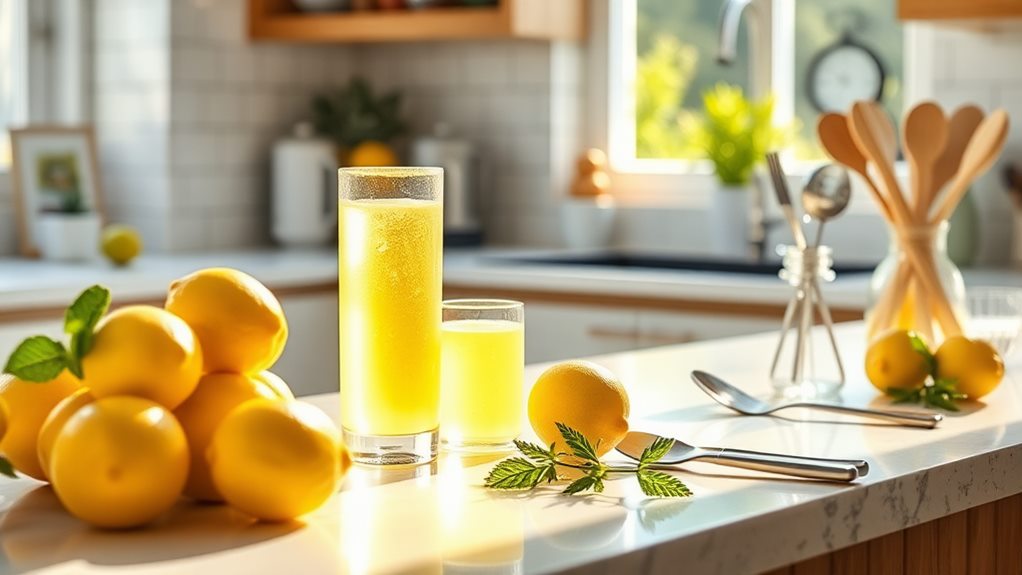
Lemon juice is a fantastic and often underestimated cleaning agent in your kitchen. Not only is it budget-friendly, but it also effectively tackles odors and stains. The natural acidity of lemon juice helps to neutralize unwanted smells while leaving a refreshing citrus scent that can really brighten up your space.
Using lemon juice for cleaning is both easy and satisfying. You can dilute it with a little water or mix it with lemon zest for an added freshness kick. Here are some practical ways to make the most of lemon juice in your cleaning routine:
| Cleaning Task | How to Use Lemon Juice |
|---|---|
| Odor Neutralizer | Simply place a bowl of lemon juice in your fridge overnight to absorb any unpleasant odors. |
| Cutting Board Sanitizer | Wipe your cutting board with lemon juice, let it sit for a few minutes, and then rinse it off to sanitize effectively. |
| Stain Remover | For stains, apply lemon juice directly to the affected area, let it sit for a while, and then wash as usual for a brighter result. |
These tips not only help keep your kitchen smelling delightful but also add a touch of natural fragrance that can uplift your cooking space. So why not grab a few lemons and start incorporating this natural cleaner into your routine today? You'll be amazed at the difference it makes!
Olive Oil for Polishing
If you want to keep your kitchen surfaces looking shiny and fresh, using olive oil is a great choice. Not only does it give a lovely shine, but it's also an eco-friendly option that won't break the bank.
To use it effectively, simply pour a small amount onto a soft cloth and buff the surfaces you want to polish. This works wonders on wood cabinets, stainless steel appliances, and even countertops. Plus, olive oil has natural properties that help repel dust and dirt, making it easier to maintain cleanliness over time.
If you're looking for alternatives, consider using a mixture of vinegar and water for a quick and effective clean, or lemon juice mixed with olive oil for a refreshing scent and added antibacterial properties.
Benefits of Olive Oil
Polishing your kitchen surfaces can turn a dull space into a bright, inviting area, and using olive oil might be one of the best-kept secrets for achieving that shine. Not only does it enhance the look of your wood furniture and countertops, but it also brings along a host of benefits that make it a smart addition to your cleaning routine.
Let's break down three important reasons to consider using olive oil for polishing:
- Natural Shine: Olive oil provides a beautiful, glossy finish that can rejuvenate your kitchen surfaces. Unlike many commercial cleaners that contain harsh chemicals, olive oil offers a safer alternative that can make your space look brand new without compromising your health or the environment.
- Health Benefits: Olive oil isn't just a staple in your cooking; it's also known for its health advantages. Packed with antioxidants, it can help reduce inflammation and promote a healthier indoor atmosphere. By choosing olive oil for your cleaning needs, you're not just brightening your kitchen but also contributing to a healthier home.
- Versatile Use: One of the best things about olive oil is its versatility. It's not limited to just polishing; it can double as a skin moisturizer, a hair conditioner, and even a leather conditioner. By incorporating olive oil into your cleaning routine, you're utilizing a product that serves multiple functions throughout your home.
Application Techniques Explained
When it comes to using olive oil to polish your kitchen surfaces, a few easy techniques can really enhance the outcome. First, grab a clean, dry microfiber cloth—this is key because microfiber is excellent at picking up dust and dirt, ensuring a smooth application.
Pour a small amount of olive oil onto the cloth; remember, a little goes a long way! It's better to start with less oil since you can always add more if necessary. This approach helps avoid that greasy residue that nobody wants on their countertops.
Now, let's talk about the application. Use gentle circular motions to spread the olive oil across your surfaces. This method does more than just polish; it conditions materials like wood and stainless steel, making them look their best.
If you encounter stubborn spots, give those areas a bit more attention. Let the olive oil work its magic by allowing it to soak in and lift away any grime.
Once you've treated the entire surface, take a second clean cloth to buff away any excess oil. This step is crucial because it ensures you end up with a beautiful, streak-free finish.
Eco-Friendly Alternative Solutions
Try using olive oil as a practical and eco-friendly way to polish your kitchen surfaces. It's a natural choice that not only shines up wood and stainless steel beautifully, but also helps you embrace sustainable practices by steering clear of harsh chemicals.
Here's how you can maximize the use of olive oil in your cleaning routine:
- Mix with Citrus Extracts: For an added touch of freshness and cleaning power, mix olive oil with lemon or orange juice. The natural disinfectant properties of citrus not only enhance your cleaning efforts but also leave your kitchen smelling wonderful.
- Infuse with Herbal Ingredients: Consider making herbal-infused olive oil by adding herbs like rosemary or thyme. These not only add a delightful fragrance but also bring additional antibacterial benefits to your cleaning solution.
- Use Biodegradable Cloths: When applying your olive oil mixture, opt for a soft cloth made from biodegradable materials. This choice ensures that your cleaning efforts are truly eco-friendly and align with your sustainable lifestyle.
Essential Oils for Scent
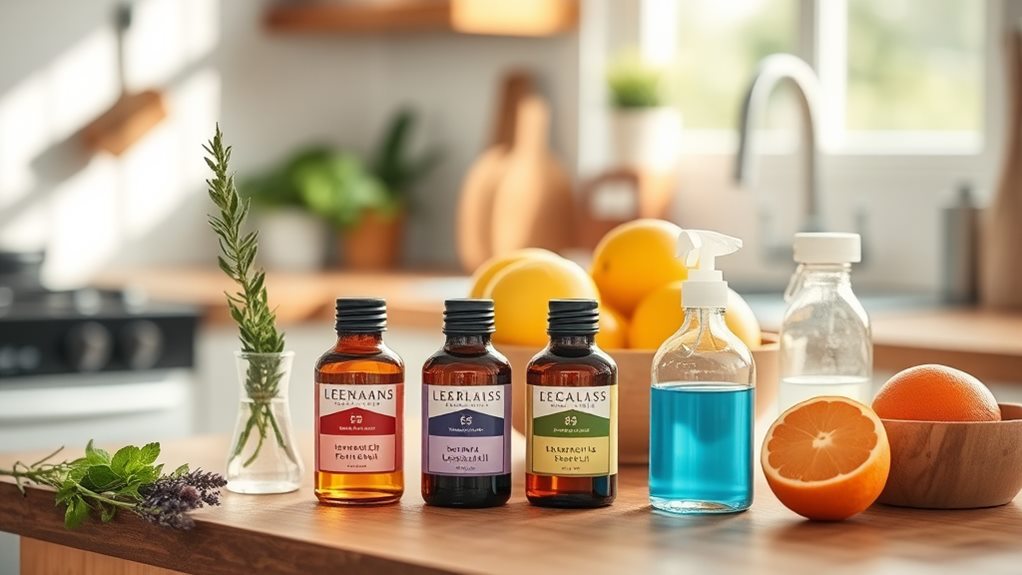
Keeping your kitchen clean doesn't have to be a chore that smells like a cleaning product aisle. You can easily add a pleasant aroma to your space by using essential oils in your cleaning routine. These natural scents do more than just freshen the air; they bring various benefits that make your cleaning time more enjoyable.
For example, lavender isn't only known for its lovely scent, but it also offers stress relief and has antibacterial properties. This makes it an excellent choice for creating a calming atmosphere while you scrub away.
If you're looking for something that energizes the room, citrus blends like lemon and orange are fantastic. Their bright, uplifting scents can instantly change the vibe of your kitchen and their natural acidity is great for tackling greasy messes.
Eucalyptus is another great option; it effectively neutralizes odors and fills the space with a refreshing, invigorating aroma. You might also want to try peppermint oil. Its invigorating scent can help keep you alert and focused, plus it has the added bonus of deterring pests.
Don't forget about tea tree oil. This oil is a powerhouse when it comes to cleaning because of its antifungal and antibacterial properties. It's especially useful in the kitchen where hygiene is essential.
The best part? You can mix and match these oils to create a scent that you love. Experimenting with different combinations can lead to a unique fragrance that makes cleaning feel less like a chore and more like a pleasant experience.
Salt for Tough Grime
Tackling tough grime in your kitchen doesn't have to be a chore—using salt can make it much easier! Salt acts as a natural abrasive, which means it's great for scrubbing away those stubborn stains and residue that can build up over time. You can create a simple salt paste or scrub to help with your cleaning tasks.
Let's break down how to use salt effectively:
- Salt Paste: To make a salt paste, mix salt with a little water or vinegar to form a thick consistency. Apply this paste directly to the grimy areas and let it sit for a few minutes. After that, grab a sponge and scrub away. Rinse the area thoroughly, and you'll be amazed at the sparkling results!
- Salt Scrub: For tougher jobs, try making a salt scrub. Combine salt with baking soda and a few drops of dish soap. This mixture works wonders on greasy surfaces like stovetops and countertops. Just apply it to the dirty area, scrub with a sponge, and rinse!
- Deodorizing: Salt isn't just for scrubbing; it can also help eliminate odors in your kitchen. If your cutting boards or sink are smelling a bit funky, sprinkle some salt on them, let it sit for a few minutes, and then rinse. You'll be left with a fresh, clean scent.
Using salt for cleaning not only helps remove grime but also provides an eco-friendly option for those looking to minimize chemical use in their homes.
It's a simple and effective solution that can make a real difference in your kitchen cleaning routine!
Cornstarch for Shine
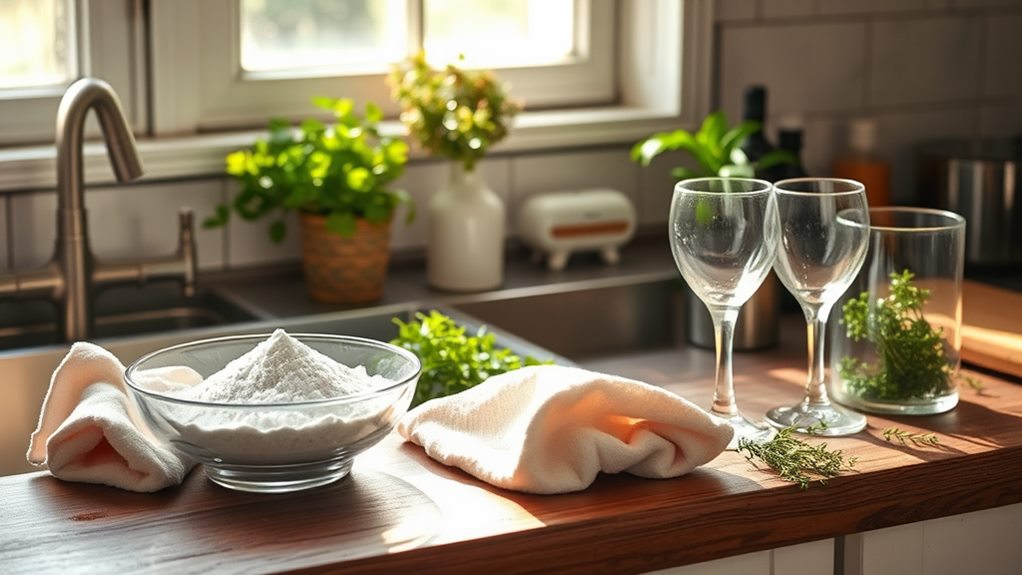
Getting a sparkling clean kitchen can be really simple with cornstarch. This common kitchen staple does more than just thicken sauces; it's also an excellent natural cleaner that can help you achieve a brilliant shine without using harmful chemicals.
One of the standout ways to use cornstarch is for polishing your surfaces. Whether it's your countertops, appliances, or sinks, cornstarch can help them shine like new.
To get started, just mix a few tablespoons of cornstarch with water to form a paste. This mixture works wonders on stainless steel and glass surfaces. Simply apply it, then wipe it off with a soft cloth. You'll be surprised at how well it eliminates smudges and leaves everything gleaming without streaks.
But that's not all—cornstarch can also freshen up your kitchen. If you have carpets or rugs, sprinkle some cornstarch on them and let it sit for a little while before vacuuming. The cornstarch absorbs odors, giving your kitchen a much fresher scent.
Whether you need to polish your silverware or clean your windows, using cornstarch is a cost-effective solution that yields fantastic results.
Hydrogen Peroxide for Disinfection
Hydrogen peroxide isn't just an affordable disinfectant; it can really enhance how you clean your kitchen. Thanks to its antibacterial qualities, it's an ideal choice for safe and effective cleaning, whether you're scrubbing surfaces or keeping mildew at bay.
Plus, it's eco-friendly, making it a reliable option for those who care about the environment.
Let's take a look at three practical ways to add hydrogen peroxide to your cleaning routine:
- Disinfecting Surfaces: For everyday cleaning, grab a bottle of 3% hydrogen peroxide. It's perfect for wiping down countertops, cutting boards, and sinks. This solution not only kills germs but is also safe for areas where you prepare food, giving you peace of mind while you cook.
- Stain Removal: Do you have tough stains on your fabrics or carpets? Simply apply hydrogen peroxide directly onto the stain and let it sit for a few minutes. Afterward, blot the area with a clean cloth. You'll be amazed at how well it lifts those stubborn marks!
- DIY Cleaners: You can easily whip up your own cleaning spray. Just mix hydrogen peroxide with water in a spray bottle, and you'll have a versatile solution that's great for sanitizing kitchen appliances and surfaces—all without the use of harsh chemicals.
Incorporating hydrogen peroxide into your cleaning routine not only helps keep your home germ-free but also promotes a healthier living space for you and your family.
Give it a try and see the difference it makes!
Castile Soap Versatility
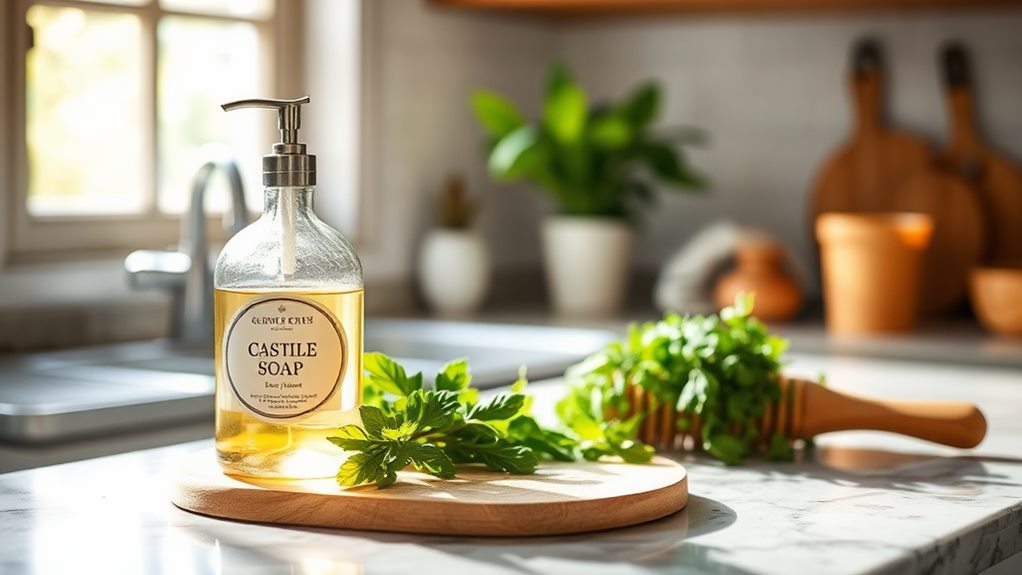
You might be surprised to learn just how handy Castile soap can be in the kitchen. This all-natural soap is packed with benefits that make it an essential item for your cleaning routine.
It's incredibly versatile, allowing you to create effective cleaning solutions for all sorts of surfaces, whether it's your countertops or kitchen appliances.
To whip up a straightforward all-purpose cleaner, simply combine one part Castile soap with ten parts water in a spray bottle. This mixture makes it easy to tackle dirt and grime, leaving your surfaces looking spotless.
If you need an alternative to traditional dish soap, just mix a few drops of Castile soap into warm water, and you're set!
You can also get creative with homemade Castile soap recipes for laundry detergent or floor cleaner. For laundry, try mixing one cup of Castile soap with a cup of baking soda and a cup of vinegar. Give it a good shake, and you've got a powerful natural detergent that works wonders on your clothes!
What makes Castile soap even better is its biodegradable nature, which means it's not just effective, but it also helps you live a more eco-friendly lifestyle.
By incorporating this versatile soap into your cleaning routine, you'll discover countless ways to keep your kitchen fresh and clean without spending a fortune.
Give it a try, and you might just find that it's a game changer for your home!
Frequently Asked Questions
Can I Mix Vinegar With Baking Soda for Cleaning?
Absolutely, mixing vinegar with baking soda is a great cleaning hack! Vinegar is fantastic for cutting through grease and disinfecting surfaces, while baking soda provides a bubbly reaction that helps lift dirt and grime. This combination not only makes your cleaning tasks more effective but also adds a bit of fun to the process.
For example, if you have a stubborn stain in your kitchen sink, you can sprinkle some baking soda directly on the stain, then pour vinegar over it. The fizzing action that occurs will help break down the grime, making it easier to scrub away. Just be sure to rinse the area with water afterward for a sparkling finish. Using these simple ingredients can make your cleaning routine more efficient and enjoyable!
Is Lemon Juice Safe for All Types of Surfaces?
Lemon juice is great for its natural antibacterial properties and its refreshing scent. However, it's important to know that it's not suitable for every surface. For instance, if you have marble or granite countertops, you should steer clear of using lemon juice on them, as it can cause damage. To be on the safe side, always test a small, inconspicuous area before cleaning the whole surface. This way, you can ensure that your surfaces remain in good condition while still benefiting from the cleaning power of lemon juice.
How Do I Store Homemade Cleaning Solutions?
To store your homemade cleaning solutions effectively, it's best to use either glass or plastic containers. This choice is important because these materials are less likely to react with your cleaning mixtures compared to metal or other materials. Make sure to label each container clearly so you can easily identify the contents later. This step is crucial as it helps prevent any mix-ups, especially if you have multiple solutions on hand.
Keeping your cleaning solutions in a cool, dark place is also essential. Light and heat can break down the ingredients, reducing their effectiveness over time. Most homemade solutions are best used within a month for optimal results, so it's a good idea to create a habit of checking your supplies regularly. For instance, if you make a vinegar and baking soda cleaner, store it in a dark cupboard, and consider writing the date on the label to remind yourself when it's time to make a fresh batch. By following these simple steps, you can ensure your cleaning products remain potent and ready for use when you need them.
Are These Cleaning Tips Safe for Pets and Children?
Absolutely, these cleaning tips are designed with the safety of both pets and children in mind. By using natural ingredients, you reduce the risk of exposing them to harmful chemicals, which is crucial for their health. For instance, instead of using commercial cleaners that often contain harsh substances, you can opt for vinegar and baking soda, which are not only effective but also safe around your little ones and furry friends.
It's also important to keep an eye on pets and kids after you've cleaned to ensure they're not in contact with any wet surfaces or freshly cleaned areas until they're completely dry. This way, you can enjoy a clean home without worrying about their safety. Remember, maintaining a safe environment for them while keeping your space tidy is key to a happy household!
How Often Should I Clean My Kitchen Using These Methods?
To keep your kitchen in top shape, it's important to set a cleaning schedule that works for you and your family. For the busiest areas, like countertops and the sink, aim to wipe them down daily. This prevents the buildup of crumbs and spills, which can attract pests and make your space feel uninviting.
Once a week, tackle surfaces and appliances. A good example is giving your stovetop a thorough scrub; this not only helps with hygiene but also makes cooking more enjoyable when everything looks clean and tidy.
Don't forget about deep cleaning! Set aside some time each month to address tasks that often get overlooked, like cleaning out the fridge and organizing the pantry. This helps you keep track of what you have on hand and reduces food waste.
Conclusion
Want to keep your kitchen sparkling clean without spending a fortune? Incorporating some simple, natural cleaning methods into your routine can make a big difference. For instance, vinegar is a powerhouse when it comes to cutting through grease and grime. You can mix equal parts vinegar and water in a spray bottle for an easy kitchen cleaner. Baking soda, on the other hand, works wonders for scrubbing surfaces and deodorizing the fridge—just sprinkle some on a damp sponge, and you're good to go!
Lemon juice is another fantastic option. Not only does it leave a fresh scent, but its natural acidity helps tackle tough stains and disinfect surfaces. You can even use lemon halves to scrub your cutting boards and countertops for an added boost of cleanliness.
These household items not only clean effectively but also contribute to a healthier home environment by eliminating the need for harsh chemicals. By making the switch to these eco-friendly alternatives, you'll find that your kitchen not only looks great but also smells inviting and stays safe for your family. So, give these budget-friendly tips a try and enjoy a cleaner, fresher space!







